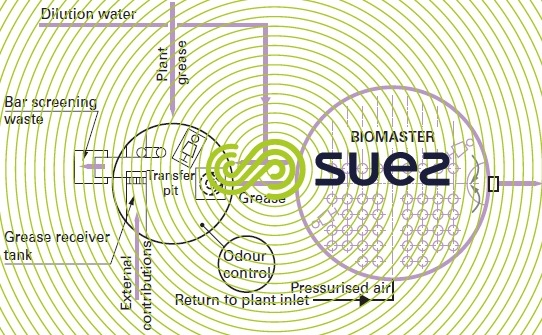the biomaster principle
Reading time:process
The Biomaster is an aerobic biological degradation process specific to this type of grease waste containing typical triglyceride COD concentrations of 50 to 300 g·L–1. The greases to be treated are brought into contact with the purifying biomass. This biomass has been adapted for breaking down the carbon substrate found in the greases.
This degradation takes place in two successive stages:
- grease is hydrolysed to form fatty acids and glycerol;
- fatty acids are hydrolysed to form H2O and CO2.
Target performances are achieved within approximately 3 weeks of contact time.
This is an exothermic process; in particular, when greases are concentrated, when nominal loading and aeration are effective, there will be a significant increase in temperature. Therefore, precautions will be required at the design stage in order to keep the added grease concentration under control: additional water in order to remain within the mesophilic range (below 42°C).
Adding reagents, nitrogen and phosphorous, will ensure that the biomass develops in a balanced medium. These reagents are added as diammonium phosphate, for instance.
Injecting lime Ca(OH)2 or another product containing calcium can be useful, acting as an anti-foaming agent.
In view of the high levels of substrate contamination, there is no need for a clarifier and for recycling the biomass to the aerator because the quantity of sludge formed will be higher than the biomass required in the aerator. Therefore, both sludge and treated water will be allowed to overflow from the Biomaster into the plant’s aeration tank.
The following diagram (figure 13) shows the complete configuration with a transfer pit for external additions.



advantages
The following constitute the main advantages of the process:
- compact stand-alone system that can easily be automated and that can be fed with grease from external sources;
- it reduces the organic load arriving at the wastewater treatment plant;
- It eliminates costs associated with the transport of grease waste to landfill sites or incineration plant;
- it requires little maintenance
- it generates no odours other than at the transfer pit;
- it contributes to the plant’s satisfactory operation because the sludge delivered by the treatment fasten the breakdown of grease that is not held back by the grease remover and limit the formation of threadlike organisms such as the Nocardia.
Bookmark tool
Click on the bookmark tool, highlight the last read paragraph to continue your reading later












